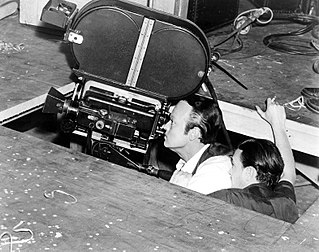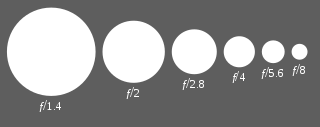
In a movie a medium shot, [1] mid shot (MS), [2] or waist shot [3] is a camera angle shot from a medium distance. [4]

In a movie a medium shot, [1] mid shot (MS), [2] or waist shot [3] is a camera angle shot from a medium distance. [4]
Medium shots are favored in sequences where dialogues or a small group of people are acting, as they give the viewer a partial view of the background, such as when the shot is 'cutting the person in half' [4] and also show the subjects' facial expressions in the context of their body language. [5] Medium shots are also used when the subject in the shot is delivering information, such as news presenters. [2] It is also used in interviews. [3] It is the most common shot in movies, [6] [7] and it usually follows the first establishing shots of a new scene or location. [7]
A normal lens that sees what the human eye sees [8] is usually used for medium shots. [7]

The medium shot shows equality between subjects and background. The dividing line between what constitutes a long shot and medium shot is not definite, nor is the line between medium shot and close-up. [7] In some standard texts and professional references, a full-length view of a human subject is called a medium shot; [6] in this terminology, a shot of the person from the knees up or the waist up is a close-up shot. In other texts, these partial views are called medium shots. [9] In principal, the medium shot is what can be seen with the human eye in a single quick glance and convey all the action taking place in that field of view. [6] [2]
Medium shots are divided into singles (a waist-high shot of one actor), group shots, over-the shoulders or two-shots (featuring two people). [6] A medium wide shot, or American shot, shows a bit more of the background but is still close enough for facial expressions to be seen, although these facial expressions would be better seen in a waist-high shot. [10]

In photography, filmmaking and video production, a wide shot is a shot that typically shows the entire object or human figure and is usually intended to place it in some relation to its surroundings. These are typically shot now using wide-angle lenses. However, due to sheer distance, establishing shots and extremely wide shots can use almost any camera type.

A point of view shot is a film scene—usually a short one—that is shot as if through the eyes of a character. The camera shows what the subject's eyes would see. It is usually established by being positioned between a shot of a character looking at something, and a shot showing the character's reaction. The POV technique is one of the foundations of film editing.

A twin-lens reflex camera (TLR) is a type of camera with two objective lenses of the same focal length. One of the lenses is the photographic objective or "taking lens", while the other is used for the viewfinder system, which is usually viewed from above at waist level.

In photography and cinematography, a wide-angle lens refers to a lens whose focal length is substantially smaller than the focal length of a normal lens for a given film plane. This type of lens allows more of the scene to be included in the photograph, which is useful in architectural, interior, and landscape photography where the photographer may not be able to move farther from the scene to photograph it.

Cinematography is the art of motion picture photography.

Steadicam is a brand of camera stabilizer mounts for motion picture cameras invented by Garrett Brown and introduced in 1975 by Cinema Products Corporation. It was designed to isolate the camera from the camera operator's movement, keeping the camera motion separate and controllable by a skilled operator.

A close-up or closeup in filmmaking, television production, still photography, and the comic strip medium is a type of shot that tightly frames a person or object. Close-ups are one of the standard shots used regularly with medium and long shots. Close-ups display the most detail, but they do not include the broader scene. Moving toward or away from a close-up is a common type of zooming. A close up is taken from head to neck, giving the viewer a detailed view of the subject's face.

In photography and cinematography, perspective distortion is a warping or transformation of an object and its surrounding area that differs significantly from what the object would look like with a normal focal length, due to the relative scale of nearby and distant features. Perspective distortion is determined by the relative distances at which the image is captured and viewed, and is due to the angle of view of the image being either wider or narrower than the angle of view at which the image is viewed, hence the apparent relative distances differing from what is expected. Related to this concept is axial magnification – the perceived depth of objects at a given magnification.
In filmmaking and video production, a shot is a series of frames that runs for an uninterrupted period of time. Film shots are an essential aspect of a movie where angles, transitions and cuts are used to further express emotion, ideas and movement. The term "shot" can refer to two different parts of the filmmaking process:
A film school is an educational institution dedicated to teaching aspects of filmmaking, including such subjects as film production, film theory, digital media production, and screenwriting. Film history courses and hands-on technical training are usually incorporated into most film school curricula. Technical training may include instruction in the use and operation of cameras, lighting equipment, film or video editing equipment and software, and other relevant equipment. Film schools may also include courses and training in such subjects as television production, broadcasting, audio engineering, and animation.

In cinematography, a low-angle shot, is a shot from a camera angle positioned low on the vertical axis, anywhere below the eye line, looking up. Sometimes, it is even directly below the subject's feet. Psychologically, the effect of the low-angle shot is that it makes the subject look strong and powerful.

Tilting is a cinematographic technique in which the camera stays in a fixed position but rotates up/down in a vertical plane. Tilting the camera results in a motion similar to someone raising or lowering their head to look up or down. It is distinguished from panning in which the camera is horizontally pivoted left or right. Pan and tilt can be used simultaneously. In some situations the lens itself may be tilted with respect to the fixed camera body in order to generate greater depth of focus.

Deep focus is a photographic and cinematographic technique using a large depth of field. Depth of field is the front-to-back range of focus in an image, or how much of it appears sharp and clear. In deep focus, the foreground, middle ground, and background are all in focus.
This article contains a list of cinematic techniques that are divided into categories and briefly described.
Camera coverage, or coverage, is the amount and kind of footage shot used to capture a scene in filmmaking and video production. The film editor uses coverage in post-production to assemble the final cut.

Portrait photography, or portraiture, is a type of photography aimed toward capturing the personality of a person or group of people by using effective lighting, backdrops, and poses. A portrait photograph may be artistic or clinical. Frequently, portraits are commissioned for special occasions, such as weddings, school events, or commercial purposes. Portraits can serve many purposes, ranging from usage on a personal web site to display in the lobby of a business.
The camera angle marks the specific location at which the movie camera or video camera is placed to take a shot. A scene may be shot from several camera angles simultaneously. This will give a different experience and sometimes emotion. The different camera angles will have different effects on the viewer and how they perceive the scene that is shot. There are a few different routes that a camera operator could take to achieve this effect.

The over-the-shoulder shot is a camera angle used in film and television, where the camera is placed above the back of the shoulder and head of a subject. This shot is most commonly used to present conversational back and forth between two subjects. With the camera placed behind one character, the shot then frames the sequence from the perspective of that character. The over-the-shoulder shot is then utilised in a shot-reverse-shot sequence where both subject's OTS perspectives are edited consecutively to create a back and forth interplay, capturing dialogue and reactions. This inclusion of the back of the shoulder allows audiences to understand the spatial relationships between two subjects, while still being able to capture a closer shot of each subject’s facial expression. In film and television, the filmmaker or cinematographer’s choice of an OTS shot’s camera height, the use of focus and lenses affect the way audiences interpret subjects and their relationships to others and space.
In filmmaking and television production, zooming is the technique of changing the focal length of a zoom lens during a shot – this technique is also called a zoom. The technique allows a change from close-up to wide shot during a shot, giving a cinematographic degree of freedom. But unlike changes in camera position, zooming does not change the perspective ; it only magnifies or reduces the size of the entire image as a whole.
This glossary of motion picture terms is a list of definitions of terms and concepts related to motion pictures, filmmaking, cinematography, and the film industry in general.